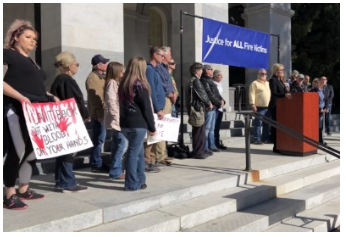CommentsCAL MATTERS--Mention Pacific Gas & Electric to Victor Porter, and the response is nothing like the bland non-opinion most Americans have of the companies that provide their electricity. (Photo above: Erin Brockovich speaks to Paradise wildfire victims.)
“They have to pay,” said Porter, a 64-year-old artist who fled for his life with his partner and their dog when the towering Camp Fire swept down on their newly renovated mobile home in Paradise. “They need to be accountable for what they’ve done here. They’ve ruined not just our lives, they’ve ruined a bunch of people who are worse off than we are.”
Investigators have not yet determined exactly who or what is to blame for the massive Camp Fire that razed Porter’s community and killed 86 people in November in Butte County. But PG&E—whose workers spotted smoke near a shorted-out utility tower above Poe Dam on the windy morning the fire started—is a prime suspect.
That could change. A prime suspect in the devastating Tubbs Fire in 2017 in California’s wine country, PG&E was exonerated in that case today, as state fire investigators announced that the source was actually a private electrical system next to a residential structure and that no state laws had been broken. The utility’s stock price, which had tanked from about $43 a share last year at this time to about $7, perked up on the report, to about $14.
But as the state’s largest utility prepares to file for Chapter 11 reorganization in bankruptcy court in apparent anticipation of a less forgiving Camp Fire verdict, Californians haven’t had much of an appetite for “innocent until proven guilty.”
Gov. Gavin Newsom, who could call for a special legislative session to save the utility, has simply issued a statement in response to the bankruptcy announcement, promising to take care of consumers and fire victims and make sure that progress on renewable energy goals doesn’t falter.
State lawmakers, who bent over backwards last year to try to help PG&E, one of the nation’s largest gas and electricity providers, have assiduously stood by as its bond rating has dropped to junk bond status.
“Nobody in the Capitol wants to bail out PG&E, period, exclamation point, end of story, full stop,” Sen. Bob Hertzberg, a Los Angeles-area Democrat who was Assembly speaker when PG&E filed for bankruptcy in 2001, during the Enron-related energy crisis, told a local CBS affiliate earlier this week.
Meanwhile, PG&E customers at a recent Public Utilities Commission meeting stood in line to accuse the utility of “criminal negligence” and worse.
Today PG&E released a statement saying that while its facilities did not cause the Tubbs Fire, the utility remains in financial quicksand.
“Regardless of today’s announcement, PG&E still faces extensive litigation, significant potential liabilities and a deteriorating financial situation, which was further impaired by the recent credit agency downgrade to below investment grade,” the company stated.
PG&E spokeswoman Lynsey Paulo said PG&E is committed to providing safe gas and electric service. She noted the company has a wildfire prevention program to reduce risks in the face of extreme weather.
“We understand and recognize the serious concerns raised by customers and wildfire victims and we acknowledge that while we have made progress, we have more work to do,” Paulo said. “We’re open to a range of solutions that will help make the energy system safer.”
 But PG&E’s critics—and they are legion in Northern California—aren’t buying. This week, in perhaps the most emblematic development for the embattled utility, Camp Fire victims rallied at the Capitol with legal activist Erin Brockovich, who was portrayed by Julia Roberts in the 2000 box office hit movie, demanding that the state keep PG&E out of bankruptcy court so victims wouldn’t end up being stiffed when they try to collect legal damages.
But PG&E’s critics—and they are legion in Northern California—aren’t buying. This week, in perhaps the most emblematic development for the embattled utility, Camp Fire victims rallied at the Capitol with legal activist Erin Brockovich, who was portrayed by Julia Roberts in the 2000 box office hit movie, demanding that the state keep PG&E out of bankruptcy court so victims wouldn’t end up being stiffed when they try to collect legal damages.
Brockovich, who helped build a class action lawsuit against PG&E over groundwater contamination in the town of Hinkley, characterized the utility as a “runaway monopoly” and called it deplorable for its history of deadly disasters.
“As you might be aware, PG&E and I have bumped into each other numerous times over the course of the past 28 years,” Brockovich said at the rally. “We should all be beyond frustrated. Every one of us should be good and mad.”
Though PG&E keeps the lights on for much of Northern California—and is integral to the state’s renewable energy goals through clean energy projects—Brockovich is just one in a long line of PG&E accusers. In her case, PG&E had to settle lawsuits worth hundreds of millions of dollars after investigations indicated it had contaminated the communities of Hinkley and Kettleman Hills.
But there was also the Christmas Eve 2008 explosion in a Sacramento suburb that killed one person and injured five others. State investigators later found that PG&E had installed an incorrect pipe and was slow in responding to reports of a natural gas leak before the tragedy occurred.
In 2010, eight people died and dozens more were injured when a natural gas transmission pipeline ruptured in San Bruno. The disaster was so egregious that a federal judge ordered PG&E to take out full-page ads in the San Francisco Chronicle and the Wall Street Journal describing its offenses and explaining what it would do to prevent future wrongdoing. The utility was also ordered to spend $3 million on television advertisements, the equivalent of 12,500 spots. It was later uncovered that gas pipeline records were falsified.
More recent calamities have had to do with mega wildfires in which PG&E’s electrical equipment has been the prime suspect. With the utility still on federal probation for six felonies related to the San Bruno explosion, Cal Fire has linked PG&E to 17 major wildfires in 2017.
Investigators said the utility broke a law in a dozen of those cases. Meanwhile, PG&E’s response to a couple of those 2017 fires has gotten the utility into trouble in federal court.
A U.S. District Court judge in San Francisco ordered PG&E to come to court next week to answer charges that the company violated the terms of its probation by failing to notify its probation officer that it had settled with Butte County over its role in three 2017 fires there, including one in which the county was criminally investigating PG&E for failing to trim trees near power lines. Those charges were later dropped.
The Tubbs Fire in Napa and Sonoma counties, which killed 22 people and destroyed more than 5,600 structures, was traced by Cal Fire to privately owned electrical equipment. That verdict, in theory, should have tempered some animosity, but it didn’t.
“It’s not the end of the story,” said Noreen Evans, a former state legislator now with Watts Guerra LLP representing more than 4,000 wildfire victims.
 Evans said she believes PG&E is still liable for the Tubbs Fire because private investigators and witnesses have come to different conclusions than Cal Fire, and she cited a 2015 audit by the California Public Utilities Commission that found PG&E was behind in vegetation and equipment management in the region where the Tubbs Fire started.
Evans said she believes PG&E is still liable for the Tubbs Fire because private investigators and witnesses have come to different conclusions than Cal Fire, and she cited a 2015 audit by the California Public Utilities Commission that found PG&E was behind in vegetation and equipment management in the region where the Tubbs Fire started.
“PG&E seems to be an outlier as far as public safety is concerned,” Evans said. “It seems to have a culture that doesn’t prioritize public safety and it should. That needs to change.”
Newsom acknowledged that he, like most Californians, was surprised that PG&E wasn’t blamed for the Tubbs Fire, if only because the belief that the utility was responsible “was sort baked into the narrative.” The main impact of the report, he said, was that making those fire victims whole would now become harder. And, he noted, about $17 billion of the $30 billion in fire liability PG&E had cited as a reason for bankruptcy might now be off the table.
But after an intense round of negotiations last year, lawmakers appear to have given up on trying to avert bankruptcy, Erin Brockovich notwithstanding.
“Look, I’m not sure what we can do to avoid it,” Democratic Assemblyman Chris Holden, who chairs the Assembly’s utilities and energy committee, said earlier this week. “PG&E is dealing with an avalanche coming down on top of them. It’s the impact of the 2017 fires. It’s the impact of the 2018 fires. It’s also what they are having to deal with under the San Bruno case. Their stock has tanked. They’ve got a lot of issues to navigate through, and I’m not even sure what the Legislature can do to help them solve their circumstances right at this moment.”
So fire victims like Porter are left with their losses and their frustration—and the cold comfort that even PG&E’s major shareholders were demanding this week that its entire board of directors be ousted.
Porter’s partner, 54-year-old Beth Hoffman, said she’d never seen such public hostility to a utility when she was growing up in Southern California, neither toward Southern California Edison nor toward San Diego Gas and Electric.
Near her, Somerset resident Cheyenne Ehler, 23, wielded a poster depicting red handprints and bloodstains with a message for PG&E, her electricity provider: “CAN’T BACK OUT WITH BLOOD ON YOUR HANDS.”
(Judy Lin is economy reporter for CalMatters, where this report originated.)
-cw
















